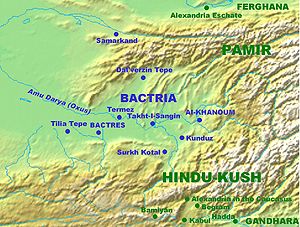
Back Baktrien ALS ባክትሪያ Amharic Bactria AN باختر Arabic باكتريا ARZ Bactriana AST Baktriya Azerbaijani باکتریا AZB Бактрия Bashkir Бактрыя Byelorussian
| Bactria Balkh | |
|---|---|
| Province of the Achaemenid Empire, Seleucid Empire, and Greco-Bactrian Kingdom | |
| 2500/2000 BC–900/1000 AD | |
Approximate location of the region of Bactria  | |
| Capital | Bactra |
| Historical era | Antiquity |
• Established | 2500/2000 BC |
• Disestablished | 900/1000 AD |
| Today part of | Afghanistan Tajikistan Uzbekistan |
Bactria (/ˈbæktriə/; Bactrian: βαχλο, Bakhlo), or Bactriana, was an ancient Iranian[1] civilization in Central Asia based in the area south of the Oxus River (modern Amu Darya) and north of the mountains of the Hindu Kush, an area within the north of modern Afghanistan. Bactria was strategically located south of Sogdia and the western part of the Pamir Mountains. The extensive mountain ranges acted as protective "walls" on three sides, with the Pamir on the north and the Hindu Kush on south forming a junction with the Karakoram range towards the east.
Called "beautiful Bactria, crowned with flags" by the Avesta, the region is considered, in the Zoroastrian faith, to be one of the "sixteen perfect Iranian lands" that the supreme deity, Ahura Mazda, had created. It was once a small and independent kingdom struggling to exist against nomadic Turanians.[2] One of the early centres of Zoroastrianism, and capital of the legendary Kayanian dynasty, Bactria is mentioned in the Behistun Inscription of Darius the Great as one of the satrapies of the Achaemenid Empire; it was a special satrapy, ruled by a crown prince or an intended heir.[1] Bactria was the centre of Iranian resistance against the Macedonian invaders after the fall of the Achaemenid Empire in the 4th century BC, but eventually fell to Alexander the Great. After the death of Alexander, Bactria was annexed by his general, Seleucus I.[3]
The Seleucids lost the region after the declaration of independence by the satrap of Bactria, Diodotus I; thus began the history of the Greco-Bactrian, and later the Indo-Greek, Kingdoms. By the second century BC, Bactria was conquered by the Parthian Empire, and, in the early first century, the Kushan Empire was formed by the Yuezhi within Bactrian territories. Shapur I, the second Sasanian King of Kings of Iran, conquered western parts of the Kushan Empire in the 3rd century, and the Kushano-Sasanian Kingdom was formed. The Sasanians lost Bactria in the 4th century, but reconquered it in the 6th century. Bactrian (natively known as ariao, 'Iranian'),[4] an Eastern Iranian language, was the common language of Bactria and surroundings areas in ancient and early medieval times.
The Islamization of Bactria began with the Muslim conquest of Iran in the 7th century. Bactra was centre of an Iranian Renaissance in the 8th and 9th centuries,[5] and New Persian as an independent literary language first emerged in this region. The Samanid Empire was formed in Eastern Iran by the descendants of Saman Khuda, a Persian from Bactria, beginning the spread of the Persian language in the region and the decline of the Bactrian language.
- ^ a b Saydali Mukhidinov (2018). "Ancestral Home of Indo-Aryan Peoples and Migration of Iranian Tribes to Southeastern Europe". SHS Web of Conferences. 50: 01237. doi:10.1051/shsconf/20185001237. S2CID 165176167.
- ^ J. K. (July 1913). "Bactria: the History of a Forgotten Empire. By H. G. Rawlinson, M.A., I.E.S. Probsthain's Oriental Series". Journal of the Royal Asiatic Society. 45 (3): 733–735. doi:10.1017/s0035869x00045470. ISSN 1356-1863.
- ^ Yusupovich, Kushokov Safarali (2020-10-28). "The Emergence Of Religious Views Is Exemplified By The Southern Regions". The American Journal of Social Science and Education Innovations. 02 (10): 143–145. doi:10.37547/tajssei/volume02issue10-22. ISSN 2689-100X.
- ^ Foundation, Encyclopaedia Iranica. "Welcome to Encyclopaedia Iranica". iranicaonline.org. Retrieved 2023-07-31.
- ^ Asiatic Papers. Bactra Retrieved 11 March 2023
© MMXXIII Rich X Search. We shall prevail. All rights reserved. Rich X Search
